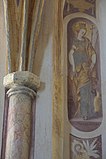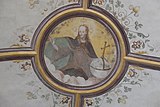Walburgiskapelle (Klosterseeon)
The Walburgis Chapel (also St. Walburg or St. Walburgis ) in the Klosterseeon district of the Upper Bavarian community of Seeon-Seebruck was built around 1000 AD on an island of the Seeoner See that has since grown into the mainland and belonged to the Benedictine monastery on the large neighboring island. After an eventful history, the Walburgis Chapel finally came into the possession of the Seeon-Seebruck community in 1969, which uses it as an event location and organizes tours there for culturally interested visitors.
history
Built as a side church of the Benedictine monastery Seeon shortly after its foundation in 994 AD, St. Walburgis served the Benedictine nuns of the local convent as a place of worship. It became a hospital church in the 13th century and a parish church in the 15th century . After fire damage, St. Walburgis was extensively redesigned from 1561 onwards. This resulted in art-historically outstanding murals made with very valuable pigments in the Mannerist style , whose masters have not yet been able to be identified. These paintings were first whitewashed in a uniform ocher around 1646. The interior was then whitewashed four more times in 350 years. In the 18th century the roof structure was renewed and the liturgical design was recreated in the Rococo style . In 1804 the church was sold together with the Benedictine monastery to the master baker Franz Xaver Distler from Munich, who passed it on to his daughter in 1815. In 1852 Amélie von Leuchtenberg acquired the property and established the Russian Orthodox cemetery of St. Walburgis. A famous burial site there belongs to Anna Anderson . St. Walburgis was donated to the Seeon community in 1969 by the Leuchtenberg family.
Mannerist murals
The aim of the most recent restoration (2002 to 2006) was, in addition to stabilizing the structure, to restore this spatial arrangement from the late 16th century with its high-quality paintings. As head restorers, Johann Brunner and his wife Zuzana designed this project. The restoration of the wall paintings was an extremely big challenge for everyone involved. Because there are only very few comparable works of this era that have been preserved as a closed room image with strictly delimited thematic groups. The state of preservation of the art treasure in St. Walburgis, which had been whitewashed several times, turned out to be unexpectedly unstable during the uncovering. There were extensive losses from cracks in the building, as well as flaking, efflorescence and sintering of the plaster, and the original colors did not adhere well to the substrate. As a result, far fewer areas could be exposed without damage than was originally hoped. Large areas of the area had to be preserved without uncovering. In coordination with the State Office for Monument Preservation, those responsible decided to achieve the goal of restoring the spatial impression of around 1580 by adding lost and hidden painting as a reconstruction using reversible technology on the respective reconstruction or conservation layer.
literature
- Gerald Dobler: Seeon, St. Walburgis. A regained gem of the Mannerist art . Verlag Josef Fink, Lindenberg im Allgäu 2008, ISBN 978-3-89870-527-1 .
Web links
- History of the Seeon Monastery Seeon Monastery
Individual evidence
- ↑ Gerald Dobler: Seeon, St. Walburgis ... , Josef Fink, Lindenberg im Allgäu 2008. P. 33.
- ^ The restoration of the Walburgis Chapel in Seeon . Documentation by the Bergmann GmbH office
- ↑ Gerald Dobler: Seeon, St. Walburgis ... , Josef Fink, Lindenberg im Allgäu 2008. p. 4.
- ↑ Gerald Dobler: Seeon, St. Walburgis ... , Josef Fink, Lindenberg im Allgäu 2008. pp. 6-9.
Coordinates: 47 ° 58 ′ 29.9 " N , 12 ° 26 ′ 46.1" E






